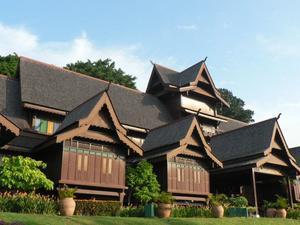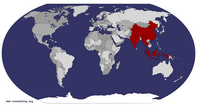Advertisement
Published: August 31st 2005

 Sultan's Palace
Sultan's Palace
Magnificent Malay building reconstructed close to the original according to sketches in an ancient chronicleThis time we planned to stay some time in Malaysia before heading to Indonesia once again. Leaving Singapore and entering Malaysia was really a piece of cake, the Malaysian immigration being far less rigorous than the Singaporean one. We soon arrived in Johor Bahru and there it did not take us long to catch a bus to
Melaka. We arrived quite late in the night (around 10:30), took a taxi whose driver spoke excellent English and was a real chatterbox disclosing some interesting information like the usual taxi price to us. We feared that the place we had chosen to stay on would no longer be open at that late hour of the day, as it was not a hotel but a privately run guesthouse. But we were lucky, after ringing the bell of the Kancil Guest House for several minutes the landlady showed her friendly face. The guesthouse did not offer rooms with attached bathrooms, but the place was so clean (if Fatima did not cook, she and her husband were busy cleaning, they had no staff) and the building so charming that we were happy to have decide for this guesthouse. Set within an old Chinese ancestral home, it

 Porta de Santiago
Porta de Santiago
All that is left of the pre-colonial fort...features: a small but enchanting garden, an airy kitchen open on one side, where the guests are welcome for breakfast and a chat with Fatima (which she loves a lot), from where one wooden staircase leads upwards to the vicinity of the upper bathrooms, a couple of single rooms on the ground floor and more rooms upstairs, to the right and left of a beautiful veranda. The whole building was abundantly decorated with Malaysian handicraft and each room was charmingly painted, ours for instance in different shades of light brown. A lovely guesthouse indeed! The only weird thing was that you had to pay for even the smallest extra you wished for, like sheets, towels, toilet paper or even battery loading.
Even before the European invasion and when Singapore was but a fishing village, Melaka had already achieved worldwide fame. Under the auspices of the Melaka Sultanate, founded in the early 15th century, political and cultural life flourished; it rapidly became a cosmopolitan market town, trading spices and textiles, its sophisticated literature and dances were benchmarks in the Malay world. One of the most outstanding achievements of the Melaka Sultanate was to create a court structure, setting a pattern

 Christ Church on Dutch Square
Christ Church on Dutch Square
Like most of the Dutch buildings in the historical centre, this church was also painted in brick-redof government that was to last for the next five hundred years. By the beginning of the 17th century, Melaka's population had increased to 100,000 and its port would harbour up to 2,000 ships! Yet, beginning in 1511, began a series of takeovers and botched administrations involving the Portuguese, Dutch and British, causing the eventual subjugation of the Malay people. But the British colony declined since the beginning of the 19th century, to which the establishment of the free-trade port of Singapore only contributed. That is when the Chinese started flocking in, taking over former Dutch mansions. So that the Melaka of today is a modern Malaysian town as well as one that has preserved vestiges of its turbulent, multi-cultural past, sometimes the modern administration has exaggerated its efforts of preservation.
Despite Melaka's former importance, only the magnificent Ikana ke Sultana (Sultanate Palace) remains architecturally from the city's precolonial days. The palace was rebuilt true to original according to the ancient Sejarah Melayu (Malay Annals), in many ways an inestimable source of information. This building is really a beautiful example of old Malay architecture, of which we hope to see more when travelling northwards of Kuala Lumpur in the

 Malay version of a bicycle-rickshaw
Malay version of a bicycle-rickshaw
All rickshaws in the centre were imaginatively decorated with plastic flowers, ribbons and bellsmiddle of September. The centre of Melaka is split in two by the murky Sungei Melaka, on the eastern side of which lies the colonial core with Bukit (hill) St. Paul at its centre, the western bank of the river is occupied by Chinatown. The Dutch Square, the core of the so-called 'historical centre', sports a fake windmill, the Stadthuys and other historic Dutch buildings, rather dull in their architecture, all covered in brick-red paint wash (the authenticity of which is arguable). Chinatown promises a more authentic encounter with the past, especially the lavish townhouses which the expatriate members took over from the Dutch when these returned home for retirement. Already these houses' exterior is a pleasure to the eye, as much as the beautiful Chinese temples, of which we definitely had not seen enough in China, but could make up for this shortcoming now in Melaka. One temple left an especially lasting impression on us, namely the Tokong Cheng Hoon (Merciful Cloud Temple), reputed to be the oldest Chinese temple in the country. The entrance to the temple grounds is marked by a black door on which a beautiful pair of golden lions are painted and beside the door

 Melaka Stadthuys
Melaka Stadthuys
This sturdy building presides over the entire south side of the Dutch Square and today harbours the Museum of Ethnographyto the main prayer hall a pair of typical Chinese lions in red and gold stand guard. The interior of the main prayer hall is quite dark due to its black timber beams giving it a rather gloomy look. It is the elaborate roof structure which impressed us most, endowed with very artistic clay statues painted in bright colours and beautiful naturalistic paintings representing war scenes among others. We also discovered smaller chambers devoted to ancestor worship filled with small tablets bearing a photograph of the deceased. For us, this was the most beautiful and complex Chinese temple we had seen so far! In its neighbourhood we wandered through a street filled with antiques shops and other places selling handicraft of wood and bamboo (games and handbags for example) and we were not reticent and bought enough stuff to fill another parcel (the fifth already!)
There is not much left of the Portuguese, the buildings on Medan Portugis (Portuguese Square) date only from 1985. What mostly remains are churches, some od them only in ruins, like St. Paul's Church on the namesake hill, which we climbed despite the midday heat for its nice view. Melaka boasted a huge (some

 Windmill in Melaka
Windmill in Melaka
This fake artefact stands in the centre of Dutch Squaresay magnificent) fort before the European invasion but the British who believed in the supremacy of another city, ordered its destruction in order to deter future settlers. So all that is left of it today is the decrepit Porta de Santiago. Apart from Chinese temples, we found a very unusual mosque in Chinatown, its roof structure is reminiscent of a Chinese temple and its minaret looks more like part of a Hindu temple than of a Muslim piece of architecture. The only indication of this being a mosque are the loudspeakers. Amazing indeed!
Close to our hotel we found two shopping malls, the first one was less posh and apart from a supermarket housed mainly furniture or household stores. We happened to come there on a Sunday - we were attracted by loud live music - only to find the place packed. Malaysians adore shopping, what the second shopping mall only confirmed. Actually we were not really attracted by the idea of shopping, but Stephan had the idea that the complex might harbour a cinema, which indeed it did. Since we had not been to see a Bollywood film in India, a fact which by the way we regret

 Beautiful ship
Beautiful ship
Already before the Europeans came, Melaka's harbour could boast of up to 2,000 shipsa lot, we decided to watch a movie for the first time since we left Europe. First we assured that we would find subtitles in English, then we chose the film, a Chinese production called 'Seven Swords', a kung-fu version of the classical theme. The most interesting thing about the film, its original version being in Mandarin, was the fact that it was subtitled three times: once in English, then in Malaysian and also in Tamil. We were quite impressed about this display of a multicultural society. Apart from this, the film was ok, with some nice fighting scenes. When we were in the shopping centres, we loved to watch Malaysian people interact. The majority of the population is Muslim, but by far not all of the women wear headscarves; and if they do so, they use very light materials and in addition use make-up, tight jeans or tshirts, particularly the young girls. Maybe this impression is wrong or only the half of the truth. but we think that this country displays cultural and religious freedom, at least in the big cities.
In the newspapers we have read that there are problems lurking, though. Malaysia bills itself as a

 View from Bukit St Paul
View from Bukit St Paul
Although we do not know this house's name, we found it beautiful enough to be publishedmodel of peaceful multiculturalism, but despite nearly half a century of nationhood (48 years on August 31st), the races that make up its population have never been further apart. The country of 25 million has a majority population of 66% Muslim Malays, and the minority 26% Chinese and 8% Indians. Separate schools, separate friends, separate social lives, many citizens lament the lack of ties between majority Malays and the Chinese and Indians living alongside them. This may well be the case, we once had a taxi driver (a Chinese) who bitterly complained that the Muslim population was largely favoured, be it alone by the fact of polygamy (more children, more money from the state, etc). For us the remaining impression was one of a rather liberal society and that a modern version of a Muslim society is possible and can be wished for for the rest of the world.
We had a flight from Kuala Lumpur to Medan on Sumatra at 8 p.m. but did not intend to drive up to Kuala Lumpur, as the airport is in the direction of Melaka. So we took a bus to Seremban, from where we could also take a taxi should we

 Artistic decoration
Artistic decoration
Many old houses in Melaka sport similar exteriorsbe too late. We arrived in time in Seremban, though, and immediately hopped onto another local bus. Which turned out to be a hard proof for our nerves, as this bus stopped almost at every corner. In the end Klaudia did not believe in catching the plane any more, we would not be the first members of the family to miss a plane anyway. We came to the check-in counter one hour before departure, and - could still check in without any problems! A miracle had happened.
Advertisement
Tot: 0.085s; Tpl: 0.014s; cc: 12; qc: 29; dbt: 0.0382s; 1; m:domysql w:travelblog (10.17.0.13); sld: 1;
; mem: 1.1mb






















